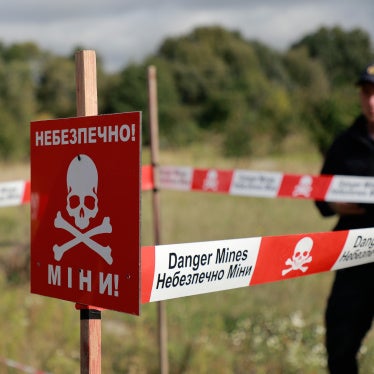Thank you, Mr. President.
Incendiary weapons inflict almost unrivaled cruelty on their victims. They cause excruciatingly painful burns that penetrate to the bone, and treatment requires the sloughing of dead skin, which has been likened to flaying a victim alive.
Those who live endure long-term psychological harm as well as permanent disfigurement, and many face difficulties reintegrating into society. Other victims do not survive, and photos taken after an incendiary weapons attack on a Syrian school show the charred bodies of children, who must have experienced unimaginable horror.
Protocol III was designed to prevent this kind of suffering, but it has failed to do so. Incendiary weapons have been used in about 15 armed conflicts since the protocol’s adoption in 1980. Over the past two years alone, Human Rights Watch has documented new use in Syria and Ukraine, and it is investigating allegations of use in Libya and Yemen in 2015.
Protocol III contains two major shortcomings. First, its definition excludes weapons that have incendiary effects but are not “primarily designed” to burn. Some governments thus maintain that white phosphorus munitions, which have been used by states as well as non-state armed groups, fall outside the current definition.
Second, the protocol has weaker regulations for ground-launched incendiary weapons, such as rockets and artillery shells, than it does for air-dropped incendiary bombs. But the delivery system is irrelevant for victims, and the use of ground-launched models is increasingly common.
The solution to these problems is legally, if not politically, quite simple. Protocol III should be amended to have a definition based on the effects rather than design of the weapon. In addition, the protocol should, at a minimum, prohibit the use in concentrations of civilians of all incendiary weapons, regardless of their delivery system. An absolute ban would have the greatest humanitarian benefit.
Over the past five years, about three dozen states, along with the ICRC, UN secretary-general, and civil society, have expressed concerns about the suffering incendiary weapons cause. You have heard many speakers echo such sentiments over the past two days.
These voices are crucial, and we encourage states to continue to raise the issue.
But it is time now to move from condemnation to concrete action. CCW states parties should heed the calls to set aside time to review Protocol III. They should also seize the opportunity presented by the Fifth Review Conference to pursue significant work on incendiary weapons, with an eye to amending the protocol in a timely fashion.
Such efforts would complement, not compete with, those on lethal autonomous weapons systems. Indeed, simultaneous progress on incendiary weapons and autonomous weapons would allow the CCW to demonstrate its relevance, while advancing the protection of civilians from both existing and future means of armed conflict.
Thank you, Mr. President.








